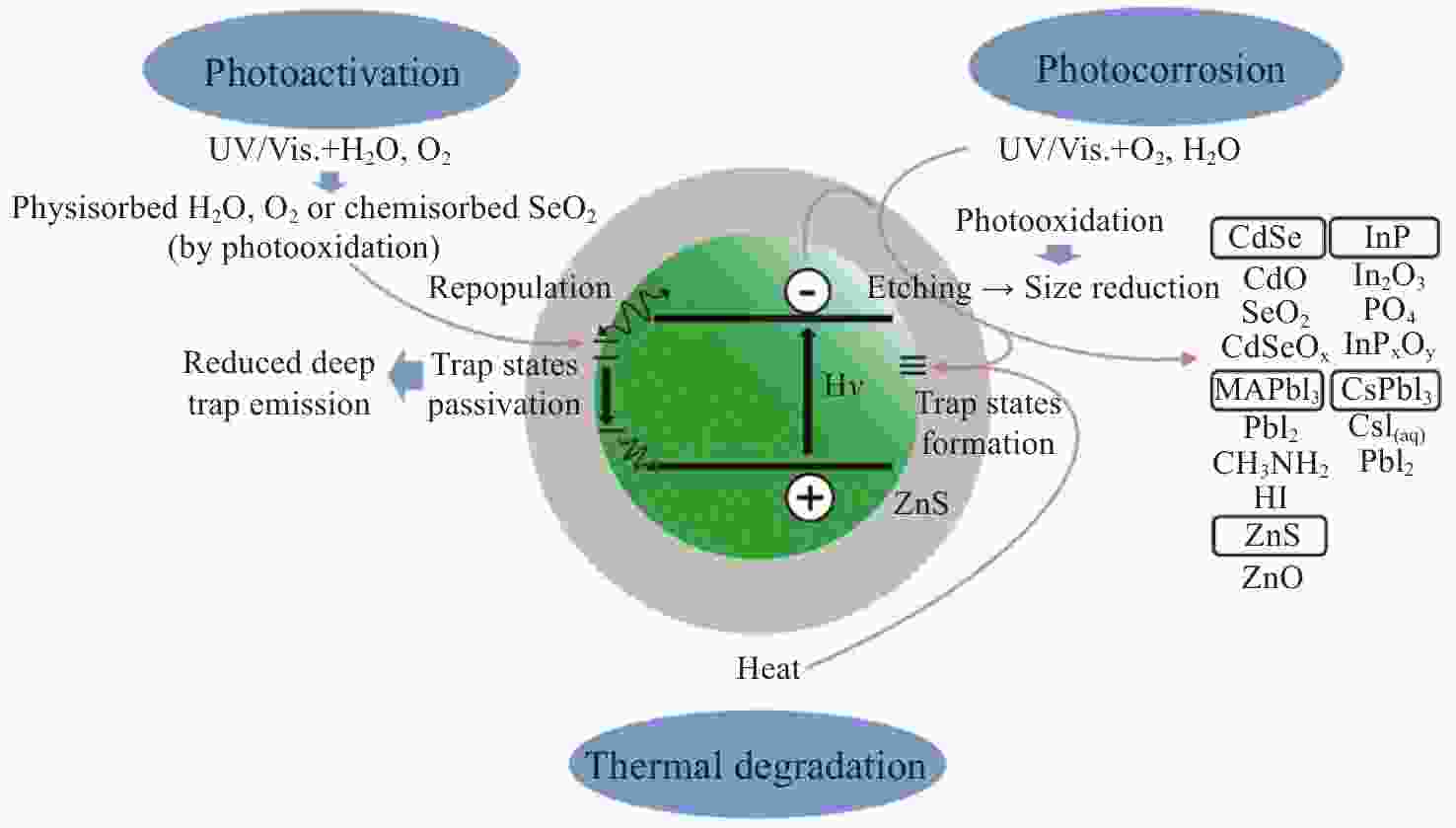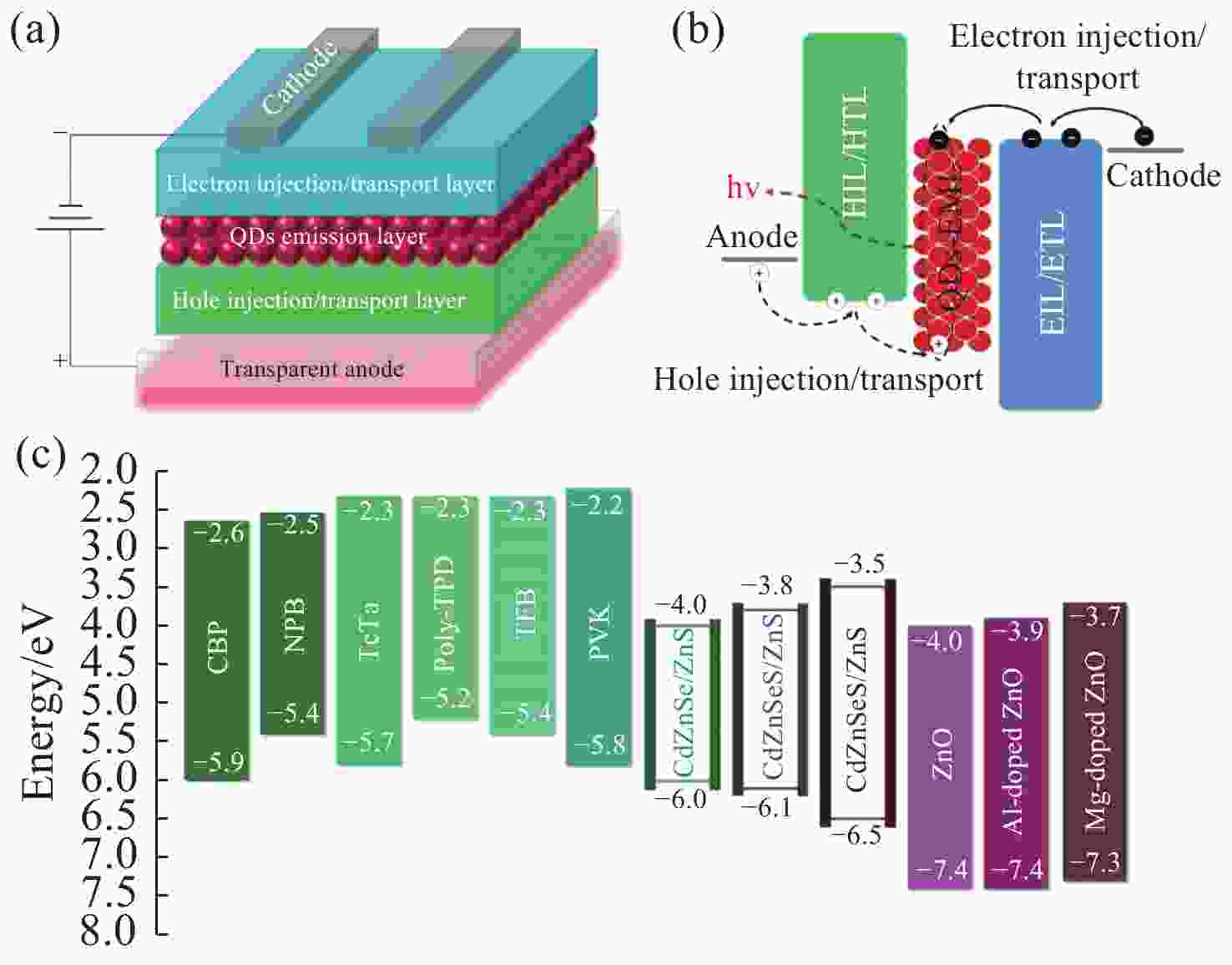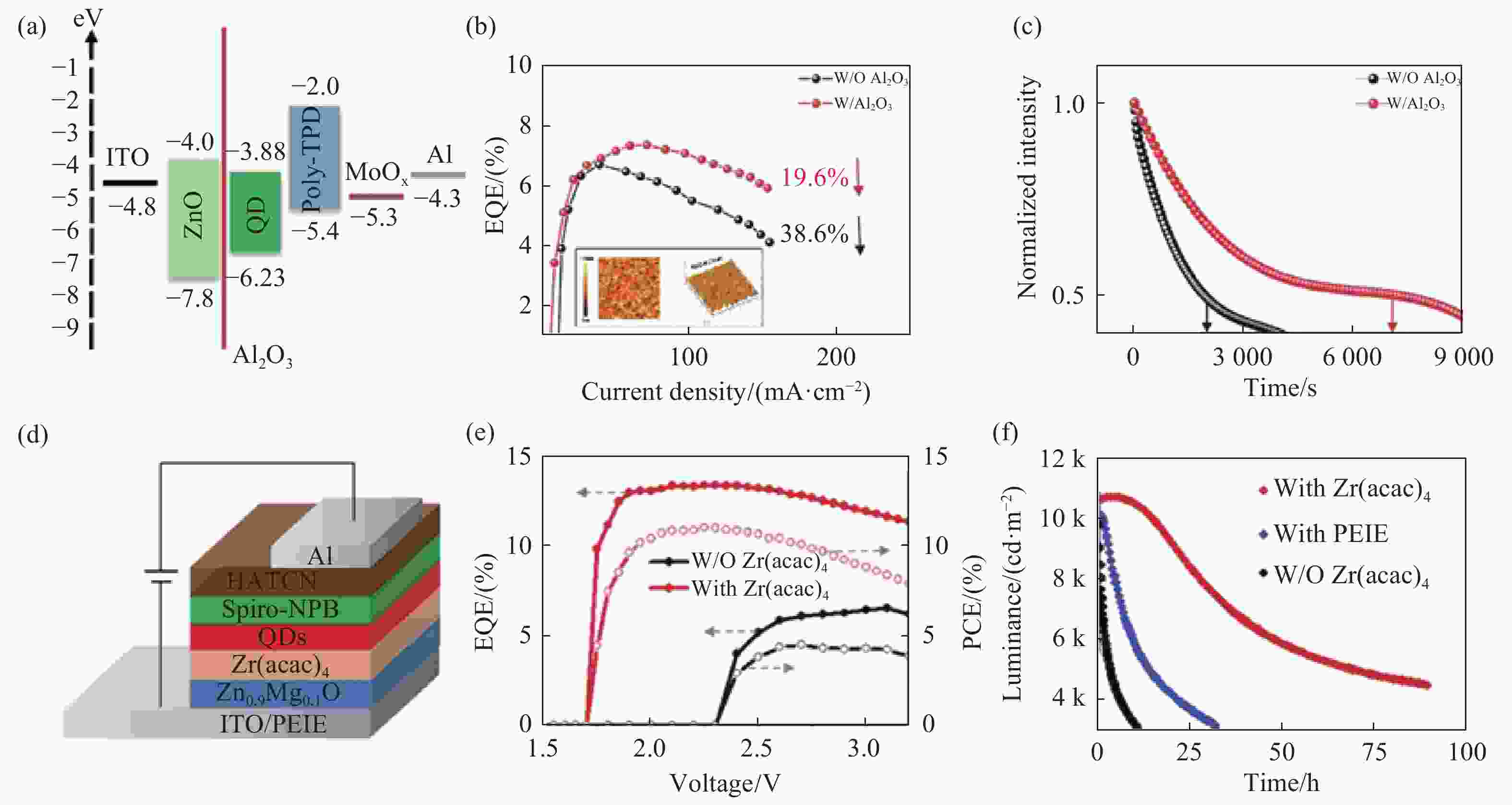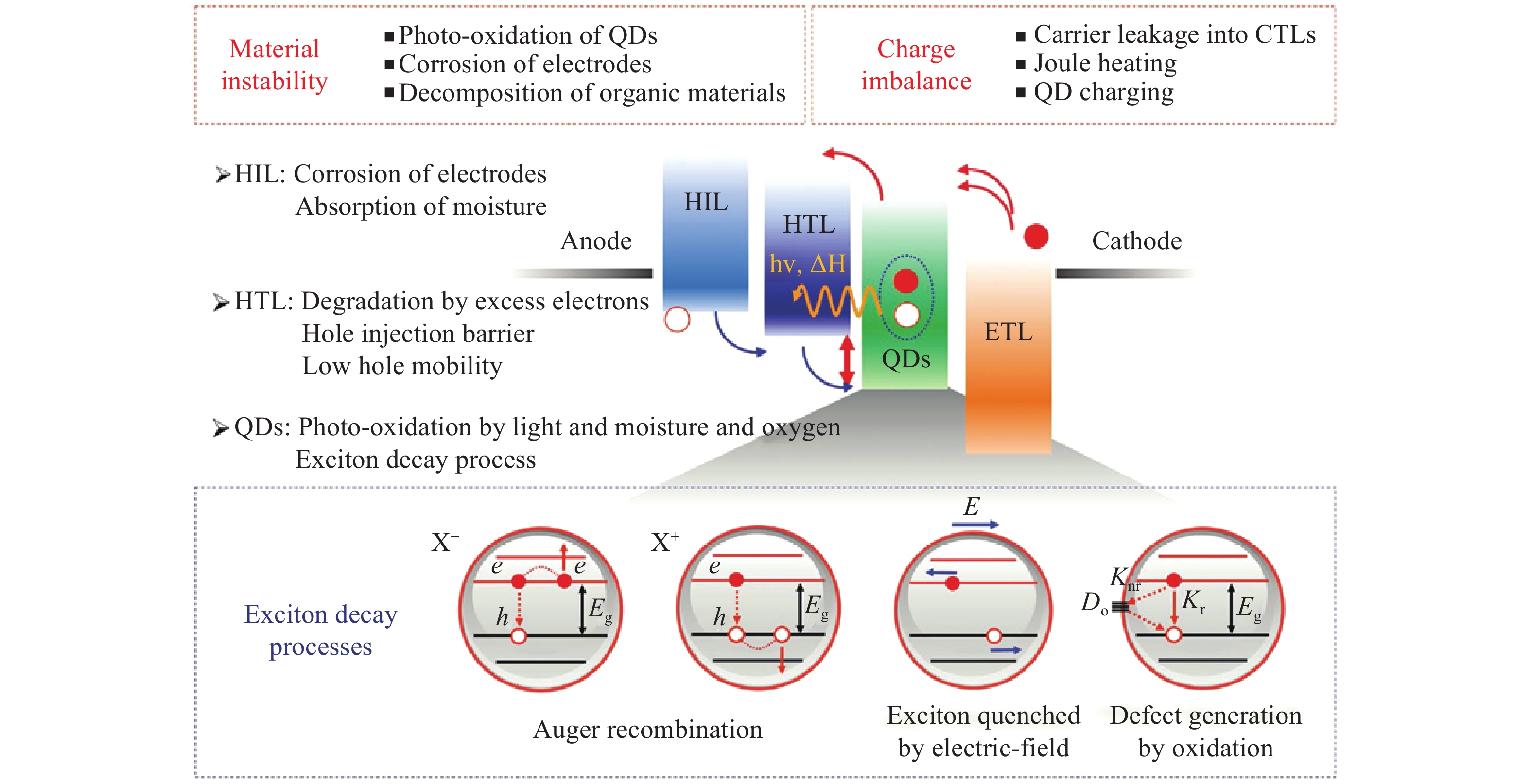-
摘要: 量子点发光二极管(QLEDs)由于具有独特的光电特性,可应用于照明和显示行业,其外量子效率(EQEs)正迅速接近商业化要求。然而,器件的稳定性和工作寿命仍然是QLEDs商业化应用面临的关键问题。本文将影响QLEDs寿命的主要因素分为功能层材料的稳定性和电荷注入不平衡两大方面,从提高量子点、电荷传输层(CTLs)的稳定性以及促进电荷平衡等方面讨论了近年来提高QLEDs稳定性的各种策略。随着人们对QLEDs降解机制认识的加深,更稳定的量子点和QLEDs器件得以开发,但是将QLEDs器件商业化仍存在很大的挑战,比如Cd的高毒性以及蓝光QLEDs的寿命和效率远低于绿光和红光相对应的水平,此外,QLEDs在高亮度(1000 cd m–2)下的稳定性较差,这些因素均限制了QLEDs的发展。因此,应进一步加大QLEDs在光电器件领域的研发力度,克服这些技术劣势,实现QLEDs未来的商业化。Abstract: Quantum dot Light-Emitting Diodes (QLEDs) are applied to the lighting and display industry for their unique photoelectric characteristics. Their External Quantum Efficiency (EQEs) is quickly meeting commercial requirements while the device’s lifetime is still one of their biggest challenges. The significant factors affecting the lifetime of QLEDs are divided into two aspects including the stability of the functional layer’s materials and charge imbalance. Various strategies for enhancing QLEDs stability are discussed including improving the stability of quantum dots, implementing Charge Transport Layers (CTLs) and promoting charge balance. With the deepening understanding of the degradation mechanism of QLEDs, more stable quantum dots and QLEDs devices have been developed. However, there are still some obstacles to the commercialization of QLEDs. For example, the high toxicity of Cd and the lifetime and efficiency of blue QLEDs are far lower than the corresponding levels of green and red QLEDs. In addition, the stability of QLEDs at high brightness (1000 cd m−2) is usually much shorter, which still limits the development of QLEDs. Therefore, research and development efforts for QLEDs should be further strengthened to overcome these technical obstacles and achieve the future commercialization of QLEDs.
-
Key words:
- quantum dots /
- quantum dots light-emitting diodes /
- lifetime /
- stability /
- charge balance
-
图 3 (a)由电极、电荷注入层(CILs)、电荷传输层(CTLs)和QDs发光层(EML)组成的QLEDs结构图;(b) QLED能级简图及其工作机理;(c)几种常用的CTLs以及不同发光颜色的合金量子点的能级比较[10]
Figure 3. (a) Schematic diagram of QLEDs consisting of electrodes, charge injection layers (CILs), charge transport layers (CTLs), and a QD’s emitting layer (EML). (b) Brief energy level diagram of a QLED and its working mechanism. (c) Band energy levels of some commonly used CTLs compared with that of alloyed QDs with different emission colors[10]
图 4 QLED量子点发射层的光学特性变化。(a) 使用CdSe/Zn0.5Cd0.5S QD的QLED在持续工作90 min下的IQE(黑色实线)和QLED的工作电压(黑色虚线)随时间变化的轨迹图,操作条件:电流密度为30 mA / cm2,QD发射薄膜的PLQY(红色圆圈),叠加反向电压(−7 V,青色正方形)并额外冷却1小时(蓝色三角形)的QD发射层的PLQY;(b) QLED中充电、热量和量子点的永久性降解对工作90 min后的量子点发射层的发光效率降低的贡献;(c)~(e)分别表示在操作0、5、30、60、90 min之后以及在施加反向电压(−7 V,青色)和冷却1 h(蓝色)之后的量子点发射层的归一化PL衰减曲线(插图:在10 ns时间延迟时用PL强度归一化的PL衰减曲线)[33]
Figure 4. Changes in the optical characteristics of the QD emissive layer during operation. (a) Operation time-dependent traces of IQE (black solid line) and the operation voltage (black broken line) of the QLED employing CdSe (r = 2.0 nm)/Zn0.5Cd0.5S (h = 6.3 nm) QDs under continuing operation at a current density of 30 mA/cm2 and a PLQY (red circle) of the QD emissive film in the corresponding device. The PLQYs of the QD emissive layer in the QLED after 90 minutes of operation after applying reverse voltage (−7 V, cyan square) and additional cooling for 1 h (blue triangle) are overlaid for comparison. (b) Contributions of charging, heat, and the permanent degradation of QDs to the reduction of luminescence efficiency of the QD emissive layer in a 90-min-operated QLED. Normalized PL decay curves of the QD emissive layer after operation for 0, 5, 30 min (c), 30, 60, 90 min (d) and (e) after applying reverse voltage (−7 V, cyan) and cooling for 1 h (blue) (insets: PL decay curves normalized with the PL intensities at 10 ns of time delay)[33]
图 5 (a) 用OA或DDT配体合成的QDs示意图;(b) QD-OA和(c)QD-DDT的变温稳态PL光谱,将样品从20 ℃加热到140 ℃(左),然后从140 ℃冷却到20 ℃(右)。插图显示了QD-OA和QD-DDT中不同的表面缺陷状态[56]
Figure 5. (a) Schematic diagrams of QDs modified with OA or DDT ligands. Temperature-dependent steady PL spectra of (b) QD-OA and (c) QD-DDT. The samples were heated from 20 ℃ to 140 ℃ (left) and then cooled from 140 ℃ to 20 ℃ (right). The insets show the different surface trap states in the QD-OA and QD-DDT[56]
图 6 (a) 各层材料的能级图[89];(b) 有无Al2O3夹层的QLEDs的效率滚降图, 插图显示ZnO/Al2O3的表面粗糙度[89];(c) 有无Al2O3中间层的QLEDs器件寿命比较[89];(d) 红光倒置QLED的器件结构[90];(e) EQE和功率转换效率(PCE)与电压的关系图[90];(f) 器件的稳定性比较,在温度为21-24 ℃以及相对湿度为40-60%的条件下测定其稳定性[90]
Figure 6. (a) Band energy level diagram of each material[89]. (b) Efficiency roll-off of QLEDs without and with an Al2O3 interlayer. The inset shows the surface roughness of ZnO/Al2O3[89]. (c) Device lifetime of the QLEDs without and with the Al2O3 interlayer[89]. (d) The device structure of the red inverted QLEDs [90]. (e) EQE and power conversion efficiency (PCE) versus the voltage characteristics of the devices [90]. (f) Device stability. The stabilities were measured under ambient conditions (temperature: 21~24 ℃; relative humidity: 40%~60%)[90]
表 1 QLEDs的器件结构、性能和寿命
Table 1. Device structures, performances and lifetimes of QLEDs
器件结构 量子点结构 QLED颜色 EL峰位(nm) VON (V) EQE (%) 寿命 Ref ITO/PEDOT:PSS/TFB/QDs/ZnO/Al CdSe/Cd1-x ZnxSe/ZnSe 红 631 1.7 15.1 2260000 h@T50,
100 nit (n=1.80)[8] ITO/PEDOT:PSS/poly-TPD/PVK/
QDs/ZnO/AgCdSe/ CdS-RNH2 红 625 1.65 20.2 90000 h@T50,
100 nit (n=1.80)[37] ITO/PEDOT:PSS/poly-TPD/PVK/
QDs/ZnMgO/AgCdSe–CdZnS 红 624 1.7 18.2 190000 h@T50,
100 nit (n=1.80)[38] ITO/PEDOT:PSS/TFB/QDs/ZnO/Al Zn1−xCdxSe/ ZnSe/ZnS 红 602 1.8 30.9 1800000 h@T50,
100 nit (n=1.84)[6] ITO/PEDOT:PSS/TFB/QDs/ZnO/Al CdSe/ZnCdSe/ZnSe 红 − − 21.6 1600000 h@T50,
100 nit (n=1.78)[2] ITO/ZnO/QDs/CBP/TCTA/NPB/
HATCN/AlCdSe/ZnS 红 630 − 11.1 864000 h@T50,
100 nit (n=1.80)[39] ITO/V2O5/PEDOT:PSS/TFB/QDs/Au ZnCdSeS/ZnS 绿 530 2.1 18.09 13355 h@T50,
100 nit (n=1.50)[40] ITO/PEDOT:PSS/TFB/QDs/ZnO/Al ZnCdSe/ZnSe/ZnSeS/ZnS 绿 527 2.3 23.9 1655000 h@T50,
100 nit (n=1.77)[7] ITO/PEDOT:PSS/TFB/QDs/ZnO/Al CdSe/ZnSe 绿 − − 22.9 1760000 h@T50,
100 nit (n=1.82)[2] ITO/PEDOT:PSS/poly-TPD/PVK/
QDs/ Zn0.9Mg0.1O/AlCdSeS/ZnSeS / ZnS-RNH2 蓝 − − 10 10000 h@T50,
100 nit (n=1.88)[37] ITO/PEDOT:PSS/TFB/QDs/ZnO/Al ZnxCd1–xSe/ZnSe 蓝 476 − 8.05 7000 h@T50,
100 nit (n=1.64)[2] ITO/PEDOT:PSS/poly-TPD/
PVK/QDs/ ZnO/AlCdSe/ZnS 蓝 460 2.7 12.80 32705 h@T50,
100 nit (n=1.80)[41] 表 2 常见ETL的材料参数
Table 2. Parameters of common ETL materials
材料 电子迁移率/ (cm2 v−1s−1) 与Al电极间势垒差/(eV) TiO2 10-4 0.4 Alq3 10-5 1.2 ZnO 1.8×10−3 <0.4 表 3 常见HTL材料的参数
Table 3. Parameters of common HTL materials
材料 HOMO/LUMO (eV) 空穴迁移率/ (cm2 v−1s−1) TFB 5.4/2.3 1×10−2 PVK 5.8/2.2 2.5×10−6 poly-TPD 5.2/2.3 1×10−4 TPD 5.4/2.3 1.1×10−5 TCTA 5.7/2.4 1×10−5 CBP 5.9/2.9 1×10−3 -
[1] DAI X L, ZHANG ZH X, JIN Y ZH, et al. Solution-processed, high-performance light-emitting diodes based on quantum dots[J]. Nature, 2014, 515(7525): 96-99. doi: 10.1038/nature13829 [2] SHEN H B, GAO Q, ZHANG Y B, et al. Visible quantum dot light-emitting diodes with simultaneous high brightness and efficiency[J]. Nature Photonics, 2019, 13(3): 192-197. doi: 10.1038/s41566-019-0364-z [3] LI X Y, ZHAO Y B, FAN F J, et al. Bright colloidal quantum dot light-emitting diodes enabled by efficient chlorination[J]. Nature Photonics, 2018, 12(3): 159-164. doi: 10.1038/s41566-018-0105-8 [4] JI W Y, JING P T, XU W, et al. High color purity ZnSe/ZnS core/shell quantum dot based blue light emitting diodes with an inverted device structure[J]. Applied Physics Letters, 2013, 103(5): 053106. doi: 10.1063/1.4817086 [5] COLVIN V, SCHLAMP M, ALIVISATOS A. Light-emitting diodes made from cadmium selenide nanocrystals and a semiconducting polymer[J]. Nature, 1994, 370(6488): 354-357. doi: 10.1038/370354a0 [6] SONG J J, WANG O Y, SHEN H B, et al. Over 30% external quantum efficiency light-emitting diodes by engineering quantum dot-assisted energy level match for hole transport layer[J]. Advanced Functional Materials, 2019, 29(33): 1808377. doi: 10.1002/adfm.201808377 [7] LI X Y, LIN Q L, SONG J J, et al. Quantum-dot light-emitting diodes for outdoor displays with high stability at high brightness[J]. Advanced Optical Materials, 2020, 8(2): 1901145. doi: 10.1002/adom.201901145 [8] CAO W R, XIANG CH Y, YANG Y X, et al. Highly stable QLEDs with improved hole injection via quantum dot structure tailoring[J]. Nature Communications, 2018, 9(1): 2608. doi: 10.1038/s41467-018-04986-z [9] MOON H, LEE C, LEE W, et al. Stability of quantum dots, quantum dot films, and quantum dot light-emitting diodes for display applications[J]. Advanced Materials, 2019, 31(34): 1804294. doi: 10.1002/adma.201804294 [10] SUN Y ZH, JIANG Y B, SUN X W, et al. Beyond OLED: efficient quantum dot light-emitting diodes for display and lighting application[J]. The Chemical Reccord, 2019, 19(8): 1729-1752. doi: 10.1002/tcr.201800191 [11] DEMBSKI S, GRAF C, KRÜGER T, et al. Photoactivation of CdSe/ZnS quantum dots embedded in silica colloids[J]. Small, 2008, 4(9): 1516-1526. doi: 10.1002/smll.200700997 [12] CARRILLO-CARRIÓN C, CÁRDENAS S, SIMONET B M, et al. Quantum dots luminescence enhancement due to illumination with UV/Vis light[J]. Chemical Communications, 2009(35): 5214-5226. doi: 10.1039/b904381k [13] PECHSTEDT K, WHITTLE T, BAUMBERG J, et al. Photoluminescence of colloidal CdSe/ZnS quantum dots: the critical effect of water molecules[J]. The Journal of Physical Chemistry C, 2010, 114(28): 12069-12077. doi: 10.1021/jp100415k [14] MÜLLER J, LUPTON J M, ROGACH A L, et al. Air-induced fluorescence bursts from single semiconductor nanocrystals[J]. Applied Physics Letters, 2004, 85(3): 381-383. doi: 10.1063/1.1769585 [15] KIM D, FU Y, KIM S, et al. Polyethylenimine ethoxylated-mediated all-solution-processed high-performance flexible inverted quantum dot-light-emitting device[J]. ACS Nano, 2017, 11(2): 1982-1990. doi: 10.1021/acsnano.6b08142 [16] KIM J H, HAN C Y, LEE K H, et al. Performance improvement of quantum dot-light-emitting diodes enabled by an alloyed ZnMgO nanoparticle electron transport layer[J]. Chemistry of Materials, 2015, 27(1): 197-204. doi: 10.1021/cm503756q [17] SONG J ZH, LI J H, LI X M, et al. Quantum dot light-emitting diodes based on inorganic perovskite cesium lead halides (CsPbX3)[J]. Advanced Materials, 2015, 27(44): 7162-7167. doi: 10.1002/adma.201502567 [18] ZHAO Y M, RIEMERSMA C, PIETRA F, et al. High-temperature luminescence quenching of colloidal quantum dots[J]. ACS Nano, 2012, 6(10): 9058-9067. doi: 10.1021/nn303217q [19] MISZTA K, DORFS D, GENOVESE A, et al. Cation exchange reactions in colloidal branched nanocrystals[J]. ACS Nano, 2011, 5(9): 7176-7183. doi: 10.1021/nn201988w [20] ROWLAND C E, LIU W Y, HANNAH D C, et al. Thermal stability of colloidal InP nanocrystals: small inorganic ligands boost high-temperature photoluminescence[J]. ACS Nano, 2014, 8(1): 977-985. doi: 10.1021/nn405811p [21] DAVIDSON-HALL T, AZIZ H. The role of excitons within the hole transporting layer in quantum dot light emitting device degradation[J]. Nanoscale, 2019, 11(17): 8310-8318. doi: 10.1039/C8NR09560D [22] CHEN S, CAO W R, LIU T L, et al. On the degradation mechanisms of quantum-dot light-emitting diodes[J]. Nature Communications, 2019, 10(1): 765. doi: 10.1038/s41467-019-08749-2 [23] ZHANG D D, DUAN L, LI CH, et al. High-efficiency fluorescent organic light-emitting devices using sensitizing hosts with a small singlet–triplet exchange energy[J]. Advanced Materials, 2014, 26(29): 5050-5055. doi: 10.1002/adma.201401476 [24] CHEN F, GUAN ZH Y, TANG A W. Nanostructure and device architecture engineering for high-performance quantum-dot light-emitting diodes[J]. Journal of Materials Chemistry C, 2018, 6(41): 10958-10981. doi: 10.1039/C8TC04028A [25] YOU J B, MENG L, SONG T B, et al. Improved air stability of perovskite solar cells via solution-processed metal oxide transport layers[J]. Nature Nanotechnology, 2016, 11(1): 75-81. doi: 10.1038/nnano.2015.230 [26] YANG W G, HUANG X J, HARDER R, et al. Coherent diffraction imaging of nanoscale strain evolution in a single crystal under high pressure[J]. Nature Communications, 2013, 4(1): 1680. doi: 10.1038/ncomms2661 [27] KIM S, KIM J, KIM D, et al. High-performance transparent quantum dot light-emitting diode with patchable transparent electrodes[J]. ACS Applied Materials &Interfaces, 2019, 11(29): 26333-26338. [28] CUN Y K, MAI CH H, LUO Y, et al. All-solution processed high performance inverted quantum dot light emitting diodes[J]. Journal of Materials Chemistry C, 2020, 8(12): 4264-4270. doi: 10.1039/C9TC06850C [29] CAO F, WANG H R, SHEN P Y, et al. High-efficiency and stable quantum dot light-emitting diodes enabled by a solution-processed metal-doped nickel oxide hole injection interfacial layer[J]. Advanced Functional Materials, 2017, 27(42): 1704278. doi: 10.1002/adfm.201704278 [30] SHI Y L, LIANG F, HU Y, et al. High performance blue quantum dot light-emitting diodes employing polyethylenimine ethoxylated as the interfacial modifier[J]. Nanoscale, 2017, 9(39): 14792-14797. doi: 10.1039/C7NR04542E [31] QIAN L, ZHENG Y, CHOUDHURY K R, et al. Electroluminescence from light-emitting polymer/ZnO nanoparticle heterojunctions at sub-bandgap voltages[J]. Nano Today, 2010, 5(5): 384-389. doi: 10.1016/j.nantod.2010.08.010 [32] JAVAUX C, MAHLER B, DUBERTRET B, et al. Thermal activation of non-radiative Auger recombination in charged colloidal nanocrystals[J]. Nature Nanotechnology, 2013, 8(3): 206-212. doi: 10.1038/nnano.2012.260 [33] CHANG J H, PARK P, JUNG H, et al. Unraveling the origin of operational instability of quantum dot based light-emitting diodes[J]. ACS Nano, 2018, 12(10): 10231-10239. doi: 10.1021/acsnano.8b03386 [34] YE Y X, ZHENG X R, CHEN D S, et al. Design of the hole-injection/hole-transport interfaces for stable quantum-dot light-emitting diodes[J]. The Journal of Physical Chemistry Letters, 2020, 11(12): 4649-4654. doi: 10.1021/acs.jpclett.0c01323 [35] XUE X L, DONG J Y, WANG SH P, et al. Degradation of quantum dot light emitting diodes, the case under a low driving level[J]. Journal of Materials Chemistry C, 2020, 8(6): 2014-2018. doi: 10.1039/C9TC04107A [36] LIM J, PARK Y S, WU K F, et al. Droop-free colloidal quantum dot light-emitting diodes[J]. Nano Letters, 2018, 18(10): 6645-6653. doi: 10.1021/acs.nanolett.8b03457 [37] PU CH D, DAI X L, SHU Y F, et al. Electrochemically-stable ligands bridge the photoluminescence-electroluminescence gap of quantum dots[J]. Nature Communications, 2020, 11(1): 937. doi: 10.1038/s41467-020-14756-5 [38] ZHANG ZH X, YE Y X, PU CH D, et al. High-performance, solution-processed, and insulating-layer-free light-emitting diodes based on colloidal quantum dots[J]. Advanced Materials, 2018, 30(28): e1801387. doi: 10.1002/adma.201801387 [39] DAVIDSON-HALL T, AZIZ H. Significant enhancement in quantum dot light-emitting device stability via a cascading hole transport layer[J]. ACS Applied Materials &Interfaces, 2020, 12(14): 16782-16791. [40] JIANG X H, MA Y T, TIAN Y, et al. High-efficiency and stable quantum dot light-emitting diodes with staircase V2O5/PEDOT: PSS hole injection layer interface barrier[J]. Organic Electronics, 2020, 78: 105589. doi: 10.1016/j.orgel.2019.105589 [41] KHAN Q, SUBRAMANIAN A, AHMED I, et al. Overcoming the electroluminescence efficiency limitations in quantum-dot light-emitting diodes[J]. Advanced Optical Materials, 2019, 7(20): 1900695. doi: 10.1002/adom.201900695 [42] SHEN H B, CAO W R, SHEWMON N T, et al. High-efficiency, low turn-on voltage blue-violet quantum-dot-based light-emitting diodes[J]. Nano Letters, 2015, 15(2): 1211-1216. doi: 10.1021/nl504328f [43] LEE K H, LEE J H, KANG H D, et al. Over 40 cd/A efficient green quantum dot electroluminescent device comprising uniquely large-sized quantum dots[J]. ACS Nano, 2014, 8(5): 4893-4901. doi: 10.1021/nn500852g [44] LI ZH H, CHEN F, WANG L, et al. Synthesis and evaluation of ideal core/shell quantum dots with precisely controlled shell growth: nonblinking, single photoluminescence decay channel, and suppressed FRET[J]. Chemistry of Materials, 2018, 30(11): 3668-3676. doi: 10.1021/acs.chemmater.8b00183 [45] HAN C Y, YANG H. Development of colloidal quantum dots for electrically driven light-emitting devices[J]. Journal of the Korean Ceramic Society, 2017, 54(6): 449-469. doi: 10.4191/kcers.2017.54.6.03 [46] FU Y, KIM D, JIANG W, et al. Excellent stability of thicker shell CdSe@ZnS/ZnS quantum dots[J]. RSC Advances, 2017, 7(65): 40866-40872. doi: 10.1039/C7RA06957J [47] YANG ZH W, WU Q Q, LIN G L, et al. All-solution processed inverted green quantum dot light-emitting diodes with concurrent high efficiency and long lifetime[J]. Materials Horizons, 2019, 6(10): 2009-2015. doi: 10.1039/C9MH01053J [48] KIM S, KIM T, KANG M, et al. Highly luminescent InP/GaP/ZnS nanocrystals and their application to white light-emitting diodes[J]. Journal of the American Chemical Society, 2012, 134(8): 3804-3809. doi: 10.1021/ja210211z [49] JUN S, JANG E. Bright and stable alloy core/multishell quantum dots[J]. Angewandte Chemie International Edition, 2013, 52(2): 679-682. doi: 10.1002/anie.201206333 [50] PANDA S K, HICKEY S G, WAURISCH C, et al. Gradated alloyed CdZnSe nanocrystals with high luminescence quantum yields and stability for optoelectronic and biological applications[J]. Journal of Materials Chemistry, 2011, 21(31): 11550-11555. doi: 10.1039/c1jm11375e [51] YANG Y X, ZHENG Y, CAO W R, et al. High-efficiency light-emitting devices based on quantum dots with tailored nanostructures[J]. Nature Photonics, 2015, 9(4): 259-266. doi: 10.1038/nphoton.2015.36 [52] MORRIS-COHEN A J, DONAKOWSKI M D, KNOWLES K E, et al. The effect of a common purification procedure on the chemical composition of the surfaces of CdSe quantum dots synthesized with trioctylphosphine oxide[J]. The Journal of Physical Chemistry C, 2010, 114(2): 897-906. doi: 10.1021/jp909492w [53] KIM T, YOON C, SONG Y G, et al. Thermal stabilities of cadmium selenide and cadmium-free quantum dots in quantum dot–silicone nanocomposites[J]. Journal of Luminescence, 2016, 177: 54-58. doi: 10.1016/j.jlumin.2016.04.038 [54] PAN J, SHANG Y Q, YIN J, et al. Bidentate ligand-passivated CsPbI3 perovskite nanocrystals for stable near-unity photoluminescence quantum yield and efficient red light-emitting diodes[J]. Journal of the American Chemical Society, 2018, 140(2): 562-565. doi: 10.1021/jacs.7b10647 [55] KRIEG F, OCHSENBEIN S T, YAKUNIN S, et al. Colloidal CsPbX3 (X = Cl, Br, I) nanocrystals 2.0: zwitterionic capping ligands for improved durability and stability[J]. ACS Energy Letters, 2018, 3(3): 641-646. doi: 10.1021/acsenergylett.8b00035 [56] SUN Y ZH, SU Q, ZHANG H, et al. Investigation on thermally induced efficiency roll-off: toward efficient and ultrabright quantum-dot light-emitting diodes[J]. ACS Nano, 2019, 13(10): 11433-11442. doi: 10.1021/acsnano.9b04879 [57] CAO F, WU Q Q, YANG X Y. Efficient and stable inverted quantum dot light-emitting diodes enabled by an inorganic copper-doped tungsten phosphate hole-injection layer[J]. ACS Applied Materials &Interfaces, 2019, 11(43): 40267-40273. [58] YANG X Y, MUTLUGUN E, ZHAO Y B, et al. Solution processed tungsten oxide interfacial layer for efficient hole-injection in quantum dot light-emitting diodes[J]. Small, 2014, 10(2): 247-252. doi: 10.1002/smll.201301199 [59] ZHANG H, WANG S T, SUN X W, et al. Solution-processed vanadium oxide as an efficient hole injection layer for quantum-dot light-emitting diodes[J]. Journal of Materials Chemistry C, 2017, 5(4): 817-823. doi: 10.1039/C6TC04050K [60] SUN Y ZH, CHEN W, WU Y H, et al. A low-temperature-annealed and UV-ozone-enhanced combustion derived nickel oxide hole injection layer for flexible quantum dot light-emitting diodes[J]. Nanoscale, 2019, 11(3): 1021-1028. doi: 10.1039/C8NR08976K [61] YANG X Y, ZHANG Z H, DING T, et al. High-efficiency all-inorganic full-colour quantum dot light-emitting diodes[J]. Nano Energy, 2018, 46: 229-233. doi: 10.1016/j.nanoen.2018.02.002 [62] JI W Y, LIU S H, ZHANG H, et al. Ultrasonic spray processed, highly efficient all-inorganic quantum-dot light-emitting diodes[J]. ACS Photonics, 2017, 4(5): 1271-1278. doi: 10.1021/acsphotonics.7b00216 [63] WANG T, ZHU B Y, WANG S P, et al. Influence of shell thickness on the performance of NiO-based all-inorganic quantum dot light-emitting diodes[J]. ACS Applied Materials &Interfaces, 2018, 10(17): 14894-14900. [64] ZHANG Y D, WANG SH J, CHEN L, et al. Solution-processed quantum dot light-emitting diodes based on NiO nanocrystals hole injection layer[J]. Organic Electronics, 2017, 44: 189-197. doi: 10.1016/j.orgel.2017.02.023 [65] LIN J, DAI X L, LIANG X Y, et al. High-performance quantum-dot light-emitting diodes using NiOx Hole‐injection layers with a high and stable work function[J]. Advanced Functional Materials, 2020, 30(5): 1907265. doi: 10.1002/adfm.201907265 [66] WANG L X, PAN J Y, QIAN J P, et al. Performance enhancement of all-inorganic quantum dot light-emitting diodes via surface modification of nickel oxide nanoparticles hole transport layer[J]. ACS Applied Electronic Materials, 2019, 1(10): 2096-2102. doi: 10.1021/acsaelm.9b00479 [67] SUN Q J, WANG Y A, LI L S, et al. Bright, multicoloured light-emitting diodes based on quantum dots[J]. Nature Photonics, 2007, 1(12): 717-722. doi: 10.1038/nphoton.2007.226 [68] QIAN L, ZHENG Y, XUE J G, et al. Stable and efficient quantum-dot light-emitting diodes based on solution-processed multilayer structures[J]. Nature Photonics, 2011, 5(9): 543-548. doi: 10.1038/nphoton.2011.171 [69] KWAK J, BAE W K, LEE D, et al. Bright and efficient full-color colloidal quantum dot light-emitting diodes using an inverted device structure[J]. Nano Letters, 2012, 12(5): 2362-2366. doi: 10.1021/nl3003254 [70] CHO K S, LEE E K, JOO W J, et al. High-performance crosslinked colloidal quantum-dot light-emitting diodes[J]. Nature Photonics, 2009, 3(6): 341-345. doi: 10.1038/nphoton.2009.92 [71] KIM H Y, PARK Y J, KIM J, et al. Transparent InP quantum dot light-emitting diodes with ZrO2 electron transport layer and indium zinc oxide top electrode[J]. Advanced Functional Materials, 2016, 26(20): 3454-3461. doi: 10.1002/adfm.201505549 [72] XIONG X Y, WEI CH T, XIE L M, et al. Realizing 17.0% external quantum efficiency in red quantum dot light-emitting diodes by pursuing the ideal inkjet-printed film and interface[J]. Organic Electronics, 2019, 73: 247-254. doi: 10.1016/j.orgel.2019.06.016 [73] XIA F T, SUN X W, CHEN SH M. Alternating-current driven quantum-dot light-emitting diodes with high brightness[J]. Nanoscale, 2019, 11(12): 5231-5239. doi: 10.1039/C8NR10461A [74] WANG F ZH, SUN W D, LIU P, et al. Achieving balanced charge injection of blue quantum dot light-emitting diodes through transport layer doping strategies[J]. The Journal of Physical Chemistry Letters, 2019, 10(5): 960-965. doi: 10.1021/acs.jpclett.9b00189 [75] LEE Y, KIM H M, KIM J, et al. Remarkable lifetime improvement of quantum-dot light emitting diodes by incorporating rubidium carbonate in metal-oxide electron transport layers[J]. Journal of Materials Chemistry C, 2019, 7(32): 10082-10091. doi: 10.1039/C9TC02683E [76] LI ZH H, HU Y X, SHEN H B, et al. Efficient and long-life green light-emitting diodes comprising tridentate thiol capped quantum dots[J]. Laser &Photonics Reviews, 2017, 11(1): 1600227. [77] LIU Y, JIANG C B, SONG CH, et al. Highly efficient all-solution processed inverted quantum dots based light emitting diodes[J]. ACS Nano, 2018, 12(2): 1564-1570. doi: 10.1021/acsnano.7b08129 [78] LAN L H, LIU B CH, TAO H, et al. Preparation of efficient quantum dot light-emitting diodes by balancing charge injection and sensitizing emitting layer with phosphorescent dye[J]. Journal of Materials Chemistry C, 2019, 7(19): 5755-5763. doi: 10.1039/C8TC04991B [79] ZHENG L L, ZHAI G M, ZHANG Y, et al. Solution-processed blue quantum-dot light-emitting diodes based on double hole transport layers: charge injection balance, solvent erosion control and performance improvement[J]. Superlattices and Microstructures, 2020, 140: 106460. doi: 10.1016/j.spmi.2020.106460 [80] JIANG C B, ZOU J H, LIU Y, et al. Fully solution-processed tandem white quantum-dot light-emitting diode with an external quantum efficiency exceeding 25%[J]. ACS Nano, 2018, 12(6): 6040-6049. doi: 10.1021/acsnano.8b02289 [81] JIANG C B, LIU H M, LIU B Q, et al. Improved performance of inverted quantum dots light emitting devices by introducing double hole transport layers[J]. Organic Electronics, 2016, 31: 82-89. doi: 10.1016/j.orgel.2016.01.009 [82] PAN J Y, WEI CH T, WANG L X, et al. Boosting the efficiency of inverted quantum dot light-emitting diodes by balancing charge densities and suppressing exciton quenching through band alignment[J]. Nanoscale, 2018, 10(2): 592-602. doi: 10.1039/C7NR06248F [83] WANG X J, SHEN P Y, CAO F, et al. Stepwise bi-layer hole-transport interlayers with deep highest occupied molecular orbital level for efficient green quantum dot light-emitting diodes[J]. IEEE Electron Device Letters, 2019, 40(7): 1139-1142. doi: 10.1109/LED.2019.2916584 [84] TANG P Y, XIE L M, XIONG X Y, et al. Realizing 22.3% EQE and 7-fold lifetime enhancement in QLEDs via blending polymer TFB and cross-linkable small molecules for a solvent-resistant hole transport layer[J]. ACS Applied Materials &Interfaces, 2020, 12(11): 13087-13095. [85] LIU Y Y, LAN L H, LIU B CH, et al. Improved performance of inverted quantum dot light-emitting diodes by blending the small-molecule and polymer materials as hole transport layer[J]. Organic Electronics, 2020, 80: 105618. doi: 10.1016/j.orgel.2020.105618 [86] LIN Q L, WANG L, LI ZH H, et al. Nonblinking quantum-dot-based blue light-emitting diodes with high efficiency and a balanced charge-injection process[J]. ACS Photonics, 2018, 5(3): 939-946. doi: 10.1021/acsphotonics.7b01195 [87] DING K, CHEN H T, FAN L W, et al. Polyethylenimine insulativity-dominant charge-injection balance for highly efficient inverted quantum dot light-emitting diodes[J]. ACS Applied Materials &Interfaces, 2017, 9(23): 20231-20238. [88] RASTOGI P, PALAZON F, PRATO M, et al. Enhancing the performance of CdSe/CdS dot-in-rod light-emitting diodes via surface ligand modification[J]. ACS Applied Materials &Interfaces, 2018, 10(6): 5665-5672. [89] JIN H, MOON H, LEE W, et al. Charge balance control of quantum dot light emitting diodes with atomic layer deposited aluminum oxide interlayers[J]. RSC Advances, 2019, 9(21): 11634-11640. doi: 10.1039/C9RA00145J [90] LI Y F, DAI X L, CHEN D S, et al. Inverted quantum dot light-emitting diodes with conductive interlayers of zirconium acetylacetonate[J]. Journal of Materials Chemistry C, 2019, 7(11): 3154-3159. doi: 10.1039/C8TC06511J [91] LI Y, HOU X Q, DAI X L, et al. Stoichiometry-controlled InP-based quantum dots: synthesis, photoluminescence, and electroluminescence[J]. Journal of the American Chemical Society, 2019, 141(16): 6448-6452. doi: 10.1021/jacs.8b12908 [92] WON Y H, CHO O, KIM T, et al. Highly efficient and stable InP/ZnSe/ZnS quantum dot light-emitting diodes[J]. Nature, 2019, 575(7784): 634-638. doi: 10.1038/s41586-019-1771-5 -





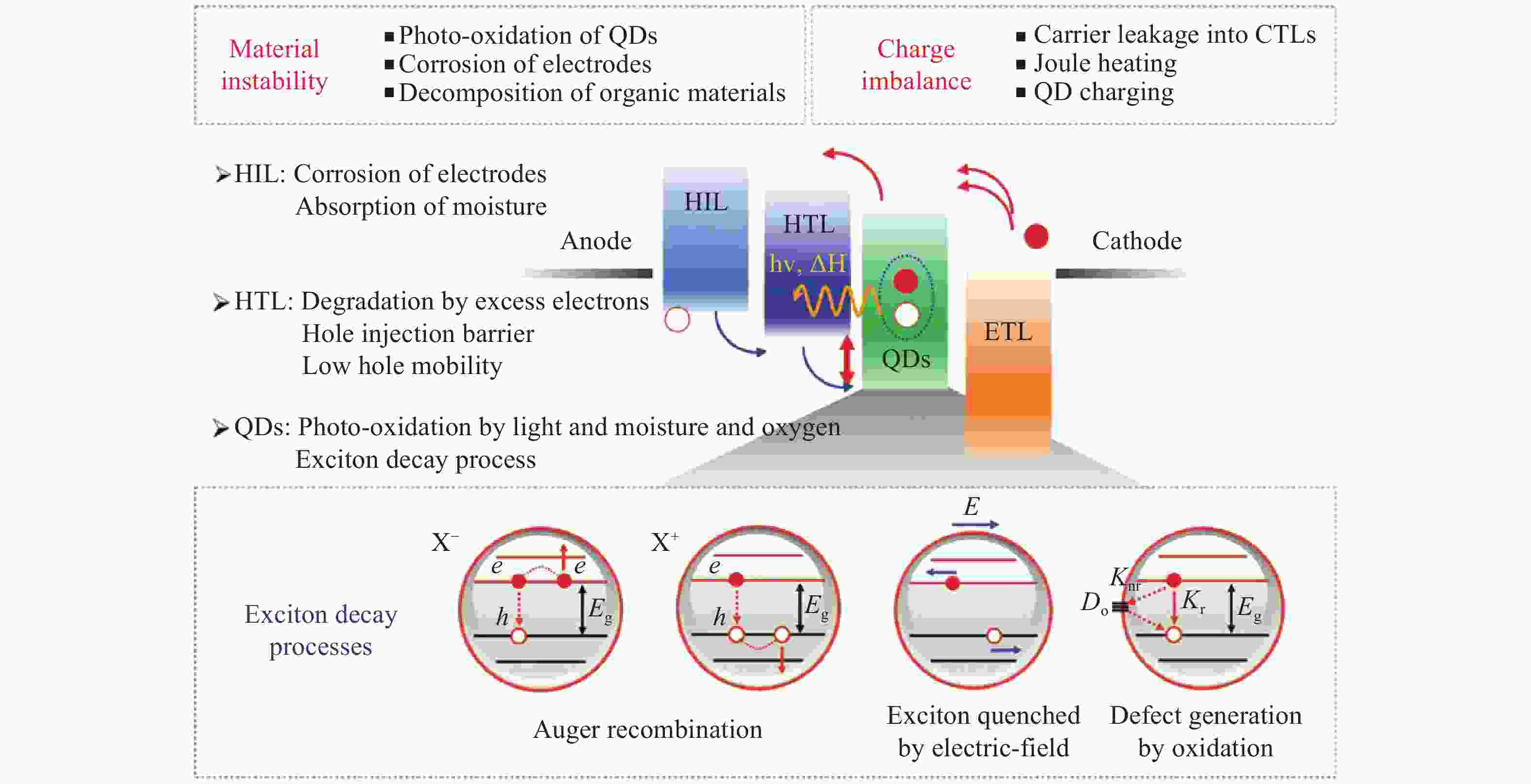
 下载:
下载:
